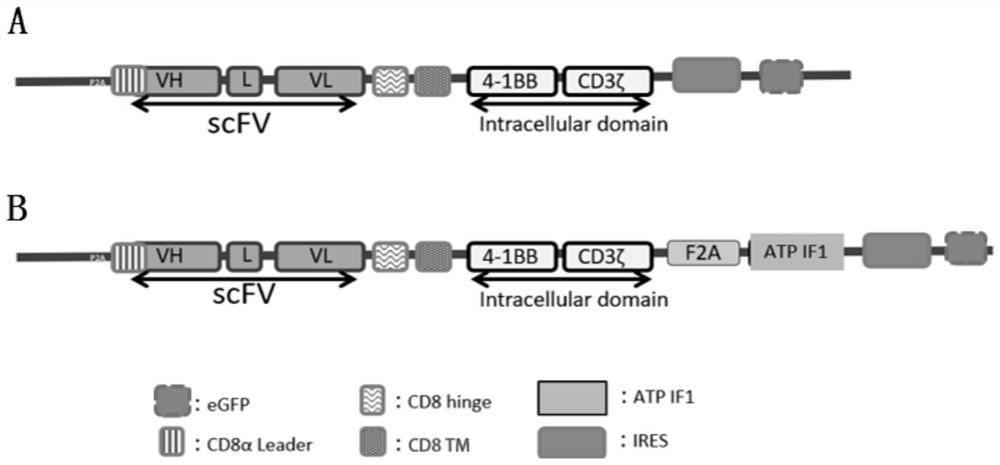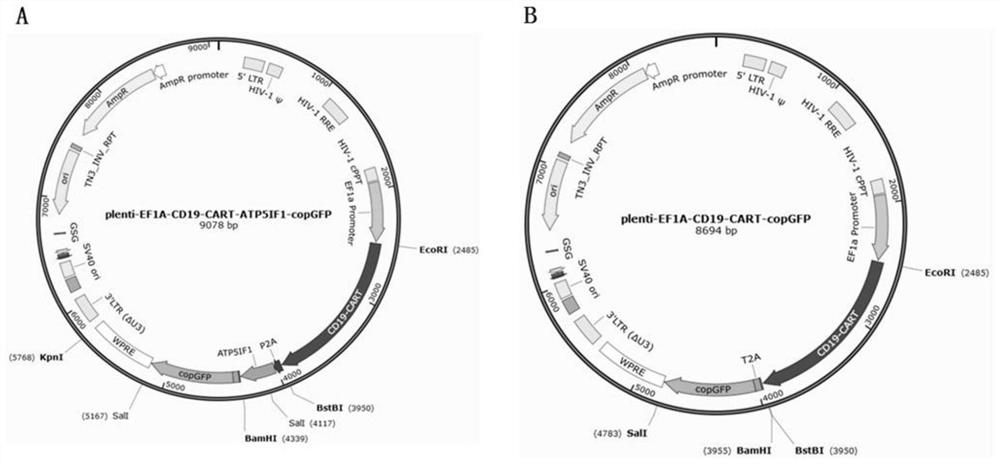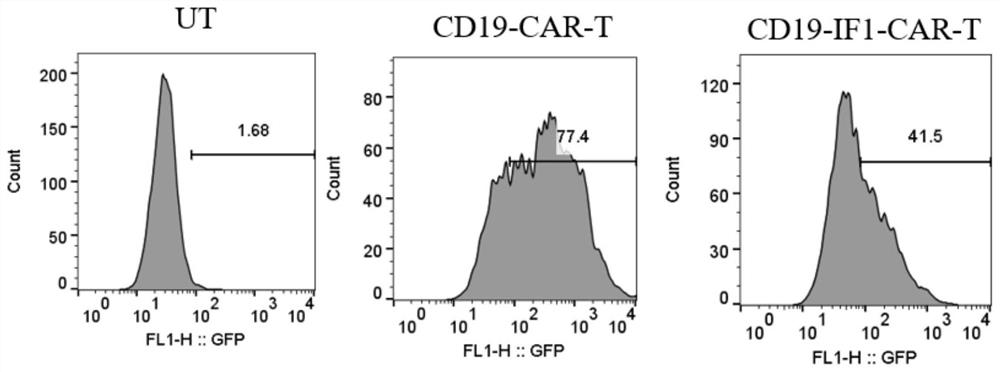CD19-targeting CAR-T cell of over-expression ATP5IF1 gene and application of CD19-targeting CAR-T cell
A cell-targeted technology, applied to CD19-targeting CAR-T cells and its application fields, to achieve the effect of increasing ratio, increasing TCM and TSCM, and significant tumor killing activity
- Summary
- Abstract
- Description
- Claims
- Application Information
AI Technical Summary
Problems solved by technology
Method used
Image
Examples
Embodiment 1
[0027] Example 1: Preparation of CD19-IF1-CAR-T cells
[0028] 1. Construction of lentiviral expression vector
[0029] (1) Construction of lentiviral vector expressing chimeric antigen receptor gene for CD19 and ATP5IF1 gene
[0030] The fusion gene in this example includes the ATP5IF1 gene and the gene encoding the CD19-targeting chimeric antigen receptor. The nucleotide sequence of the fusion gene is shown in positions 2491-4338 of SEQ ID NO. 1, wherein SEQ ID NO. Positions 3949-4020 of NO.1 are P2A restriction sites, and positions 4021-4338 are ATP5IF1 gene.
[0031] Chimeric Antigen Receptor ( figure 1 B) includes sequentially concatenated:
[0032] a. CD8 leader peptide, position 2491-2553 of SEQ ID NO.1;
[0033] b. Anti-CD19 scFv, position 2554-3279 of SEQ ID NO.1;
[0034] c. CD8 hinge region (position 3280-3414 of SEQ ID NO. 1), CD8 transmembrane region (position 3415-3477 of SEQ ID NO. 1) and CD8 intracellular region (position 3478 of SEQ ID NO. 1) -3489 bits); ...
Embodiment 2
[0055] Example 2: Determination of anti-tumor effect of CD19-IF1-CAR-T cells in vitro
[0056] 1. CD19-IF1-CAR-T cells against CD19 + NALM-6 luc+ Killing effect:
[0057] The CD19-CAR-T cells, CD19-IF1-CAR-T cells and UT cells prepared in Example 1 were mixed with 1 × 10 4 CD19 + NALM-6 Luc+ Cells were co-cultured in 96-well plates according to different ratios (E:T=5:1, 3:1, 1:1, 1:2), and after 24 hours, the firefly luciferase reporter gene (Biyuntian, One-LumiTM II) was detected. Firefly luciferase reporter gene detection kit) represents the killing activity of the corresponding CAR-T cells by the tumor cell lysis rate.
[0058] The result is as Figure 4 As shown, the CD19-IF1-CAR-T cells had a higher tumor lysis rate by measuring Luci in the cell culture supernatant ( Figure 4 ), that is, ATP5IF1-overexpressing CAR-T cells indeed enhanced their tumor-killing effect and performed better when targeting CD19.
[0059] 2. Determination of the expression level of IFN-...
Embodiment 3
[0077] Example 3: Evaluation of anti-tumor effect of CD19-IF1-CAR-T cells in vivo
[0078] 18 6-week-old NCG female mice were taken, and each mouse was injected with 1.2 × 10 6 NALM-6 Luc+ The cells were then randomly divided into 3 groups: UT cell group, CD19-CAR-T cell group and CD19-IF1-CAR-T group. One week later, 1.2 × 10 was injected into the tail vein 6 UT cells, 1.2×10 6 CD19-CAR-T cells and 1.2 × 10 6 Three groups of mice were treated with CD19-IF1-CAR-T cells, respectively. period, on day 22 ( Figure 8 A) and 28 days ( Figure 8 B) Venous blood was obtained from mouse tail and analyzed by flow cytometry for CD19 of tumor cells in mice + NALM-6 Luc+ The absolute number of cancer cells. Observe the state of the mice within 50 days and record the survival period of the mice, draw the survival curve, Figure 9 Schematic diagram of mouse survival time.
[0079] Figure 8-9 The results showed that CD19 in tumor-bearing mice injected with CD19-IF1-CAR-T cells ...
PUM
 Login to View More
Login to View More Abstract
Description
Claims
Application Information
 Login to View More
Login to View More - R&D
- Intellectual Property
- Life Sciences
- Materials
- Tech Scout
- Unparalleled Data Quality
- Higher Quality Content
- 60% Fewer Hallucinations
Browse by: Latest US Patents, China's latest patents, Technical Efficacy Thesaurus, Application Domain, Technology Topic, Popular Technical Reports.
© 2025 PatSnap. All rights reserved.Legal|Privacy policy|Modern Slavery Act Transparency Statement|Sitemap|About US| Contact US: help@patsnap.com



